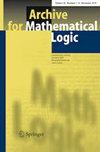递归抛光空间
IF 0.3
4区 数学
Q1 Arts and Humanities
引用次数: 0
摘要
本文关注的是如何有效运用波兰空间的概念。证明了递归波兰空间结构在空间\({\mathcal {X}}\)的有效开放子集中不存在,并探索了有效结构被积空间\(\mathbb {N}\times {\mathcal {X}}\)的有效开放子集捕获的有力证据。本文章由计算机程序翻译,如有差异,请以英文原文为准。
Recursive Polish spaces
This paper is concerned with the proper way to effectivize the notion of a Polish space. A theorem is proved that shows the recursive Polish space structure is not found in the effectively open subsets of a space \({\mathcal {X}}\), and we explore strong evidence that the effective structure is instead captured by the effectively open subsets of the product space \(\mathbb {N}\times {\mathcal {X}}\).
求助全文
通过发布文献求助,成功后即可免费获取论文全文。
去求助
来源期刊

Archive for Mathematical Logic
MATHEMATICS-LOGIC
CiteScore
0.80
自引率
0.00%
发文量
45
审稿时长
6-12 weeks
期刊介绍:
The journal publishes research papers and occasionally surveys or expositions on mathematical logic. Contributions are also welcomed from other related areas, such as theoretical computer science or philosophy, as long as the methods of mathematical logic play a significant role. The journal therefore addresses logicians and mathematicians, computer scientists, and philosophers who are interested in the applications of mathematical logic in their own field, as well as its interactions with other areas of research.
 求助内容:
求助内容: 应助结果提醒方式:
应助结果提醒方式:


